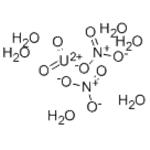Uranyl nitrate can be used as an analytical reagent, as a lighting device in the photographic industry, and in the production of fine porcelain.
Acidic solution in water of uranyl nitrate, a radioactive yellow crystalline solid. Mildly chemically toxic. Contains nitric acid. Noncombustible, but will accelerate the burning of other combustible materials if concentrated or if the water evaporates. Large quantities may explode if exposed to fire. Produces toxic oxides of nitrogen if involved in fire. Radioactive materials emit certain rays which can be detected only by instruments. Unirradiated uranium is only mildly radioactive. Minimal radiation hazard during transportation. No protective shielding is required. Non-fissile (natural or depleted) uranium, containing not more than 1.0% u-235, cannot sustain a nuclear chain reaction.
Dissolves in water forming a weak solution of nitric acid, the reaction is not hazardous.
Mixtures of metal/nonmetal nitrates with alkyl esters may explode, owing to the formation of alkyl nitrates; mixtures a nitrate with phosphorus, tin (II) chloride, or other reducing agents may react explosively [Bretherick 1979. p. 108-109]. Dissolves in water forming a weak solution of nitric acid, the reaction is not hazardous.
Radiation presents minimal risk to transport workers, emergency response personnel and the public during transportation accidents. Packaging durability increases as potential hazard of radioactive content increases. Undamaged packages are safe. Contents of damaged packages may cause higher external radiation exposure, or both external and internal radiation exposure if contents are released. Low radiation hazard when material is inside container. If material is released from package or bulk container, hazard will vary from low to moderate. Level of hazard will depend on the type and amount of radioactivity, the kind of material it is in, and/or the surfaces it is on. Some material may be released from packages during accidents of moderate severity but risks to people are not great. Released radioactive materials or contaminated objects usually will be visible if packaging fails. Some exclusive use shipments of bulk and packaged materials will not have "RADIOACTIVE" labels. Placards, markings and shipping papers provide identification. Some packages may have a "RADIOACTIVE" label and a second hazard label. The second hazard is usually greater than the radiation hazard; so follow this GUIDE as well as the response GUIDE for the second hazard class label. Some radioactive materials cannot be detected by commonly available instruments. Runoff from control of cargo fire may cause low-level pollution.
Poison by ingestion,
subcutaneous, intravenous, and
intraperitoneal routes. Mutation data
reported. A corrosive irritant to skin, eyes,
and mucous membranes. A raboactive
material. When heated to decomposition it
emits toxic fumes of NOx. See also
URANIUM.
Take uranyl nitrate hexahydrate and prepare a saturated solution with water or 0.1-1mol/L nitric acid solution at room temperature. Put it in a pressure-resistant desiccator and gradually evacuate it. After the crystals are precipitated, a part of the crystals initially precipitated is removed by filtration, and then vacuum is continued to separate out the crystals. This part of the crystals is filtered out and placed in a desiccator filled with 35% to 40% sulfuric acid, dried and stored.
Crystallise the nitrate from water by cooling to -5o, taking only the middle fraction of the solid which separates. Dry the deliquescent rhombic yellow crystals of the hexahydrate over 35-40% H2SO4 in a vacuum desiccator. The crystals reflect a greenish lustre. They are remarkable because on crushing, rubbing or shaking they show triboluminescence with occasional detonation. They are very soluble in EtOH, and solutions of the nitrate in Et2O can explode in the presence of sunlight.


